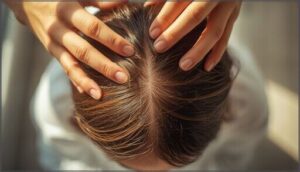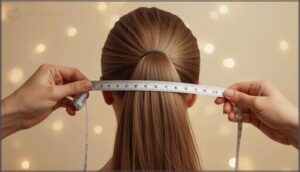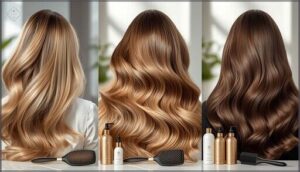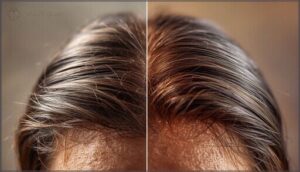This site is supported by our readers. We may earn a commission, at no cost to you, if you purchase through links.
Your scalp holds between 80,000 and 120,000 individual hair follicles, yet some people can wrap their ponytail around three times while others struggle to fill a hair tie once. The difference isn’t just about having “thick” or “thin” hair—it’s about hair density, a measurable characteristic that determines how many strands are actually growing from each square inch of your scalp.
Understanding your hair density changes everything from which products work best to why certain hairstyles fall flat or look stunning. Whether you’re dealing with visible scalp, frustrating flatness, or an unmanageable mane, knowing your density category helps you stop fighting against your hair’s natural tendencies and start working with them instead.
Table Of Contents
Key Takeaways
- Hair density measures the number of individual strands growing per square inch of your scalp (typically 80,000–120,000 total hairs), which is completely different from hair thickness—the width of each individual strand—and determines whether your hair looks full or sparse regardless of how thick each fiber actually is.
- You can assess your own density at home using two simple tests: check how easily your scalp shows through your part under bright light, or measure your ponytail circumference (under 2 inches signals low density, 2–3 inches indicates medium, and over 4 inches suggests high density).
- While you can’t change the number of follicles you were born with—since 70–80% of your density is determined by genetics—you can improve the health of existing follicles through proper nutrition (especially iron, vitamin D, and protein), targeted topical treatments like minoxidil, and professional options such as PRP therapy or hair transplants.
- Each density level requires specific care strategies: low-density hair benefits from lightweight volumizing products and minimal deep conditioning to avoid weighing it down, medium-density hair handles most balanced formulas well, and high-density hair needs richer moisturizers and more frequent cleansing to prevent product buildup and tangling.
What is Hair Density?
Hair density is simply the number of individual hair strands growing per square inch on your scalp. It’s what determines whether your hair looks full and thick or sparse and thin, regardless of how wide each strand actually is.
Let’s break down what this means for your hair, how it shows up in your everyday styling, and the three main density categories you’ll want to know about.
Definition and Key Concepts
Hair density measures how many hair strands grow per square inch of your scalp—usually between 120 and 200 hairs per square centimeter. Understanding hair density helps distinguish it from hair thickness, which refers to each strand’s width. Most healthy adults have a significant number of hairs, with 80,000 to 120,000 hairs usually found on their scalp.
Three key concepts define this trait:
- Follicular unit density: Groups of 1–5 hair follicles per unit
- Scalp hair count: Most adults have 80,000–150,000 total hairs
- Cosmetic classifications: Low, medium, or high density categories
How Hair Density Affects Appearance
Once you understand follicle counts, you’ll notice how density shapes your overall look. Higher density creates natural facial framing by adding fullness around your face, reducing scalp coverage and visibility. Lower density can increase perceived age by several years, affects your styling options, and carries psychosocial impact.
A recent study showed that an oral supplement led to increased terminal hairs. That’s why hair volume matters—it influences how hairstyles for hair density appear and provides multiple approaches for increasing hair density appearance through targeted hair styling techniques.
Categories: Low, Medium, and High Density
Your look can shift dramatically depending on which density category you fall into. These classifications help with visual assessment and density quantification:
- Low density hair: Ponytail test under 2 inches, scalp easily visible, fewer than 40–50 follicles per square centimeter
- Medium density hair: 2–3 inch circumference, moderate scalp visibility, around 50–70 follicles per square centimeter
- High density hair: Over 4 inches, scalp hard to see, more than 70 follicles per square centimeter
Understanding hair density types has clinical relevance and real cosmetic impact on your styling choices.
Hair Density Vs. Hair Thickness
Hair density and hair thickness sound like they mean the same thing, but they’re actually two completely different characteristics of your hair. One tells you how many strands you have, while the other describes how wide each strand is.
Let’s clear up the confusion and look at how these traits work together to shape your hair’s overall health and appearance.
Differences Between Density and Thickness
Many people use “thick hair” when they really mean dense hair, but these are two completely different things. Hair density measures follicle count per square inch on your scalp, while hair thickness refers to strand diameter—the actual width of each hair fiber. You can have hundreds of fine hair strands creating full visual volume, or fewer coarse hair shafts showing more scalp. Measurement methods assess these traits separately because they’re genuinely independent.
| Characteristic | Hair Density | Hair Thickness |
|---|---|---|
| What it measures | Number of follicles per square inch | Width of individual hair shaft |
| Categories | Low, medium, high | Fine (0.08mm) |
| Visual impact | Overall fullness and volume | How each fiber reflects light |
| Common mislabeling | Often called “thick” when actually high-density | Confused with density in everyday language |
How Both Traits Impact Hair Health
When follicle health and shaft thickness work together, they determine your overall hair coverage and scalp outcomes. Low density with thin strands struggles mechanically during grooming practices, breaking easier under heat or tension, while high density with coarse fibers can trap buildup and stress follicles. Hair care needs to address both traits simultaneously, because optimizing just one leaves vulnerabilities that compromise long-term hair health.
| Density + Thickness | Mechanical Behavior | Scalp Impact |
|---|---|---|
| Low density, fine shafts | High breakage risk under styling stress | Maximum UV exposure to follicles |
| High density, coarse shafts | Tangling, product buildup near roots | Increased sebum accumulation |
Common Misconceptions
Why do most people confuse “thick” with “dense”? Surveys show more than 60% mix up strand diameter (thickness) and follicle count (hair density), leading to wrong product choices. You might assume coarse, low-density hair means high volume, or blame washing for thinning when genetics drive scalp visibility. Understanding hair density versus thickness prevents misattributed causes and stops you from overestimating what styling products can deliver.
Most people confuse thick hair with dense hair, leading to mismatched products and unrealistic expectations about what styling can achieve
| Common Misconception | What People Believe | Actual Reality |
|---|---|---|
| Density vs Thickness | “Thick hair” always means many hair strands | Thickness = strand width; density = follicle count per square inch |
| Scalp Visibility | Any visible part line signals hair loss | Normal density can show scalp, especially with fine or straight hair strands |
| Product Overestimation | Volumizing shampoos permanently increase hair density | Cosmetics temporarily lift cuticles; they don’t create new follicles |
| Misattributed Causes | Frequent washing or brushing reduces hair volume | Genetics and hormones drive density; grooming habits rarely decrease follicle numbers |
| Increasing Density | Over-the-counter treatments restore childhood follicle counts | Baseline density is hereditary; reversing miniaturization fully is uncommon |
How to Measure Hair Density
Measuring your hair density doesn’t require fancy equipment or a trip to the salon, though professional methods do exist.
You can get a pretty accurate read at home using two simple tests that take just a few minutes.
Let’s walk through the most reliable ways to figure out where your hair falls on the density spectrum.
Scalp Visibility Test
Checking your scalp visibility is one of the simplest hair density measurement methods you can try at home. Part your hair in several areas—crown, sides, and back—under bright, natural lighting conditions. If your scalp shows easily, you likely have low hair density; some visibility suggests medium density; barely visible scalp indicates high density.
Remember, hair color and part width affect accuracy limitations, so repeat this self-assessment frequency every few months to track changes.
Ponytail Circumference Test
You can also use the ponytail circumference test for measuring hair density. Pull your completely dry hair—free of styling products—into a tight mid-back ponytail, then measure with flexible tape. Under 2 inches (5 cm) signals low density, 2–3 inches (5–10 cm) indicates medium, and 4+ inches (10+ cm) suggests high density.
This hair density assessment method works best on medium-to-long hair, though curl impact and length limitations can affect test reliability.
Professional Assessment Methods
When home tests like the Ponytail Test leave you uncertain, professional hair density assessment methods offer precision you can’t achieve alone. Clinicians rely on sophisticated tools that count every follicle per square centimeter:
- Trichoscopy analysis – Non-invasive dermoscopy that digitally measures density across scalp regions, generally revealing 124–200 hairs per cm² in healthy areas
- Phototrichogram imaging – Highest-standard technique capturing growth phases within a standardized 1 cm² area
- Digital image analysis – Automated platforms like TrichoScan that map follicular distribution for clinical density tests
Scalp biopsy remains the histological gold standard, though it’s reserved for diagnostic cases requiring absolute accuracy in measuring hair density.
Factors Influencing Hair Density
Your hair density isn’t just a matter of chance—it’s shaped by a mix of factors you were born with and conditions you can actually influence. Some of these elements are written into your DNA, while others relate to your overall health and daily habits.
Let’s look at the main forces that determine how many strands you’re working with.
Genetics and Hereditary Factors
Twin studies reveal genetics account for 70–80% of hair density traits, meaning your family history largely determines how many follicles you’re born with. Specific genes like SPRY1 and NRP2 shape follicle number and placement, while sex-linked genetics involving androgen receptors influence hair thinning patterns.
Ethnic differences also exist—Caucasians generally show higher follicular density than Asian or African-American populations, underscoring how understanding hair density begins with your genetic blueprint.
Nutrition and Health Conditions
Beyond genetics, your diet and overall health play powerful roles in hair density. Protein deficiency forces the body to ration resources away from follicles, while iron deficiency—one of the most common nutritional deficiencies—impairs the rapidly dividing cells that build each strand.
Vitamin deficiencies, thyroid disorders, and systemic stress from illness can all trigger increased shedding and visible thinning, showing how medical conditions affecting hair density often start inside your body.
Tips for Managing Different Hair Densities
Once you know your hair density, the real work begins—choosing the right care routine and products to keep your hair looking its best.
Each density type comes with its own set of challenges, from flat roots to overwhelming volume, but small adjustments can make a big difference.
Here’s how to tailor your approach based on whether your density falls on the low, medium, or high end of the spectrum.
Hair Care for Low, Medium, and High Density
Once you know your hair density type, you can tailor your hair care routine to work with what you’ve got. Each density level brings its own challenges and opportunities, from managing product buildup in high-density hair to creating volume in low-density hair.
- Low-Density routines: Use lightweight volumizing shampoos 2–3 times weekly, and deep condition only once a week to prevent clumping that makes your scalp more visible.
- Medium-Density balance: Cleanse with sulfate-free formulas 2–4 times weekly, and alternate between volumizing and moisturizing products across wash days for best lift and hydration.
- High-Density challenges: Wash every 2–3 days to limit product buildup, and apply rich moisturizing masks weekly from mid-length to ends to reduce tangling.
- Density routine frequency: Adjust washing schedules based on your specific density—low density benefits from less frequent deep conditioning, while high density requires more regular scalp cleansing.
Product Selection Based on Density
Your hair density determines which products truly work for you, not marketing hype. Low-density hair thrives on lightweight volumizing formulas—mousse, foam, and silicone-free conditioners—that won’t flatten your roots.
Medium-density types can handle most balanced products, from light gels to creams.
High-density hair needs richer moisturizers, heavier oils, and detangling leave-ins to manage bulk and prevent tangling without weighing down your volume.
Styling Techniques for Fuller-Looking Hair
Once you’ve chosen the right products, smart styling tips can transform your volume. The right haircut and blow-dry techniques matter more than you might think—layered haircuts can boost perceived fullness by roughly 30%, while your parting direction instantly changes how dense your hair looks.
Here are five daily habits that make a real difference:
- Flip your part regularly to prevent hair from settling flat in one position
- Blow-dry with your head upside down to lift roots away from your scalp using gravity
- Use a round brush at the roots to create tension and add measurable lift
- Direct airflow from roots to ends to smooth the cuticle while building volume
- Try a zigzag part instead of straight to increase visual coverage across your scalp
These hair styling techniques work with your natural density, not against it.
Can You Increase Hair Density?
While you can’t change the number of hair follicles you were born with, you can take steps to improve the health and growth of the follicles you have. This means focusing on strategies that stimulate dormant follicles, strengthen existing strands, and prevent further thinning.
Let’s look at the most effective approaches to improving your hair density.
Diet and Lifestyle Adjustments
Your follicles need more than good genes—they need the right fuel. Dietary deficiencies, especially in iron, vitamin D, and protein, directly impact hair growth and density.
Studies show that correcting these nutritional deficiencies, combined with stress management techniques, adequate sleep quality, and limiting alcohol consumption, can improve follicular health.
A balanced diet for hair growth aids the building blocks your scalp needs to maintain density.
Topical Treatments and Supplements
Beyond nutrition, topical treatments for hair density offer measurable results. Minoxidil efficacy is well-documented—5% formulations increase hair growth considerably in studies. Finasteride safety has improved with topical versions, reducing systemic exposure while maintaining effectiveness.
Combination therapies often outperform single agents, though addressing nutrient deficiencies remains foundational. Supplement effectiveness varies, benefiting those with confirmed deficiencies most. Your follicles respond when hair care targets real gaps.
Professional and Clinical Options
When at-home methods plateau, several professional options can improve hair density with documented results. Hair transplant surgeries restore follicles permanently, while PRP therapy and microneedling may boost growth when combined with topicals. Low Level Laser Therapy increases counts per square centimeter over months.
For visual enhancement without regrowth, scalp micropigmentation creates the illusion of denser coverage quickly.
Frequently Asked Questions (FAQs)
Does hair density change throughout your lifetime?
Yes, your hair density shifts across your lifetime. Think of it as a slow-motion transformation: follicle numbers peak at birth, then shrink as your scalp expands during childhood and aging gradually thins coverage.
Can stress permanently reduce your hair density?
Stress generally triggers temporary hair thinning through disrupted growth cycles, but chronic stress combined with genetic pattern hair loss or autoimmune conditions can accelerate miniaturization and follicle damage, potentially causing permanent density reduction.
Do men and women have different density levels?
Men and women generally start with similar baseline hair densities, but hormonal influence—especially androgens—drives sex-specific miniaturization patterns.
Men experience more severe hair loss through clinical scales like Norwood, while women show diffuse thinning via Ludwig grading.
How does hair density affect hair transplant results?
Your donor area density dramatically shapes transplant outcomes. Surgeons generally need 80–100 follicles per cm² to harvest enough grafts safely, while achieving 35–45 transplanted units per cm² creates satisfying, natural-looking fullness without compromising graft survival.
Is hair density linked to ethnicity or race?
Hair density and ethnicity are linked through genetic predisposition. Research shows Caucasian populations generally display higher scalp region densities, while African-descent groups often have lower counts.
Fiber diameter and measurement methods also vary across hair types, influencing density assessments.
Conclusion
Think of your hair density as your scalp’s blueprint—fixed at birth, unchangeable in number, but entirely manageable with the right approach.
Now that you understand what’s hair density and how it shapes your hair’s behavior, you can finally choose products, styles, and treatments that complement your unique follicle count instead of working against it.
Your density isn’t a limitation; it’s simply the starting point for healthier, more confident hair decisions.











